Communication Plan for Investors
- Mechanisms:
- Clear facts;
- Evidence;
- Reasons;
- Support;
- Frequency:
- 3 times
- At the beginning;
- During the process;
- At the end;
- Initiators’ Responsibilities:
- Be clear and definite;
- Don’t make jokes;
- Rely on facts;
- Recipients’ Responsibilities:
- Analyze information;
- Don’t make fast decisions;
- Provide/refuse a financial support;
- Keep promises that are given.
Communication with investors plays an important role. This group of stakeholders should know why a project is offered and what benefits they can get. It s expected to provide a communication with clear facts with the help of which a manager explains the necessity of investors, evidence that proves the rationale of the project, reasons that show that this kind of work can help people, and support to prove that there are expectations that make people work and then buy the production.
It is enough to talk to investors three times per project: at the beginning – to discuss plans and details of the work, during the process – to inform that everything is going fine, and at the end of the work – to describe the results and share the achievements. Still, the investors are free to talk to a manager when they find it necessary. The same happens to a manager.
- Initiators’ Responsibilities:
- Be clear and definite (investors will not read between the lines and try to guess what a manager wants to talk about).
- Don’t make jokes (though jokes are appreciated, investors is not the group of people to use jokes on them).
- Rely on facts (investors do not need too many words, just facts that prove the effectiveness of their cooperation).
- Recipients’ Responsibilities:
- Analyze information (listen carefully each piece of information offered).
- Don’t make fast decisions (evaluation is the key for investor’s work).
- Provide/refuse a financial support (as soon as all facts and reasons are mentioned, it is necessary to conclude if a project is worth attention or not).
- Keep promises that are given (oral or written agreements are developed to discuss the details of cooperation).
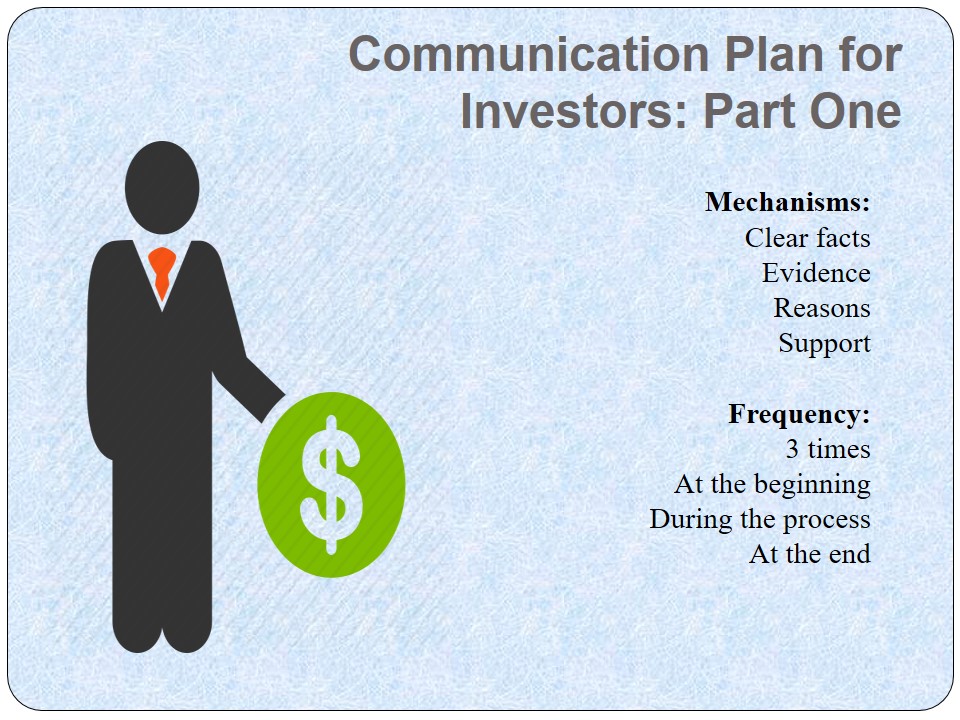
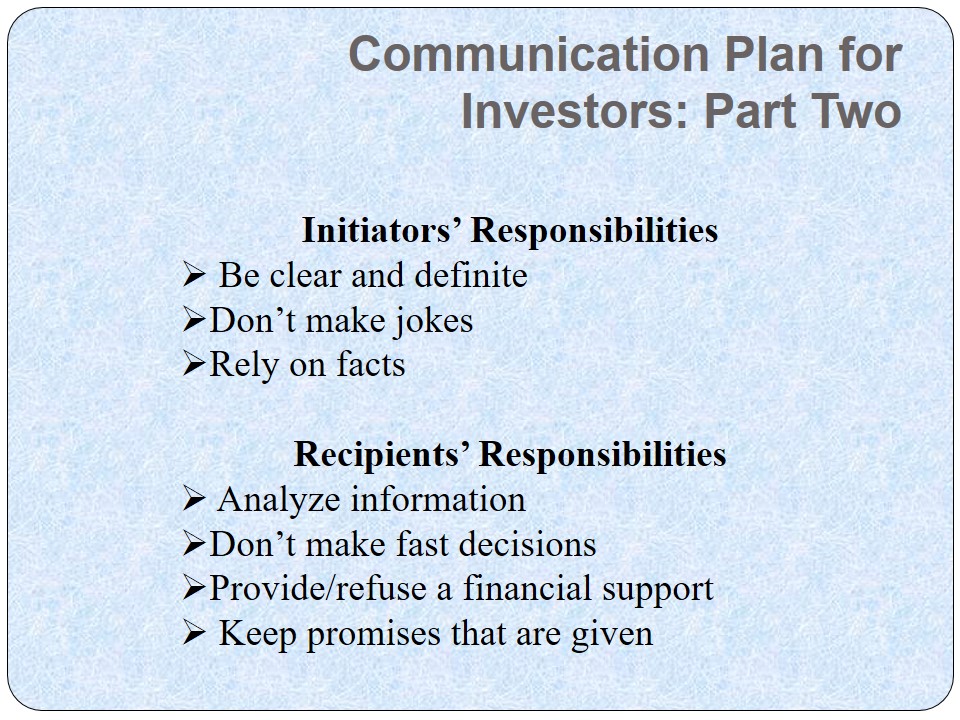
Communication Plan for Employees
- Mechanisms:
- Motivation;
- Jokes;
- Explanations.
- Frequency:
- During the whole working process.
- Initiators’ Responsibilities:
- Inform about the goals and details of a working process;
- Discuss working conditions;
- Provide information about potential salary;
- Involve people in a working process;
- Recipients’ Responsibilities:
- Listen and memorize the information about a project;
- Ask questions to clarify all necessary points;
- Share personal ideas on how to develop a project;
- Analyze the options and make conclusions.
Communication with employees, as an important group of stakeholders, is one of the most easiest and interesting parts. First, there is no necessity to prove the correctness of the chosen production. The main task is to motivate people work, identify their roles, and provide with several reasons for why they have to join a team. Jokes can make this communication process easier and focus on the things that are interesting to workers. It is possible to talk about their dreams and the ways how they come true (Flannes & Levin, 2005).
The frequency of communication with employees depends on the way of how a project is performed. As a rule, it is expected that a project manager meets employees every day to identify the progress or challenges of the process.
Communication with such group of people is not as formal as talks to investors. Still, the outcomes of such communication define the development of a project considerably because of the responsibilities of both parties:
- Initiators’ Responsibilities:
- Inform about the goals and details of a working process;
- Discuss working conditions;
- Provide information about potential salary;
- Involve people in a working process.
- Recipients’ Responsibilities:
- Listen and memorize the information about a project;
- Ask questions to clarify all necessary points;
- Share personal ideas on how to develop a project;
- Analyze the options and make conclusions.

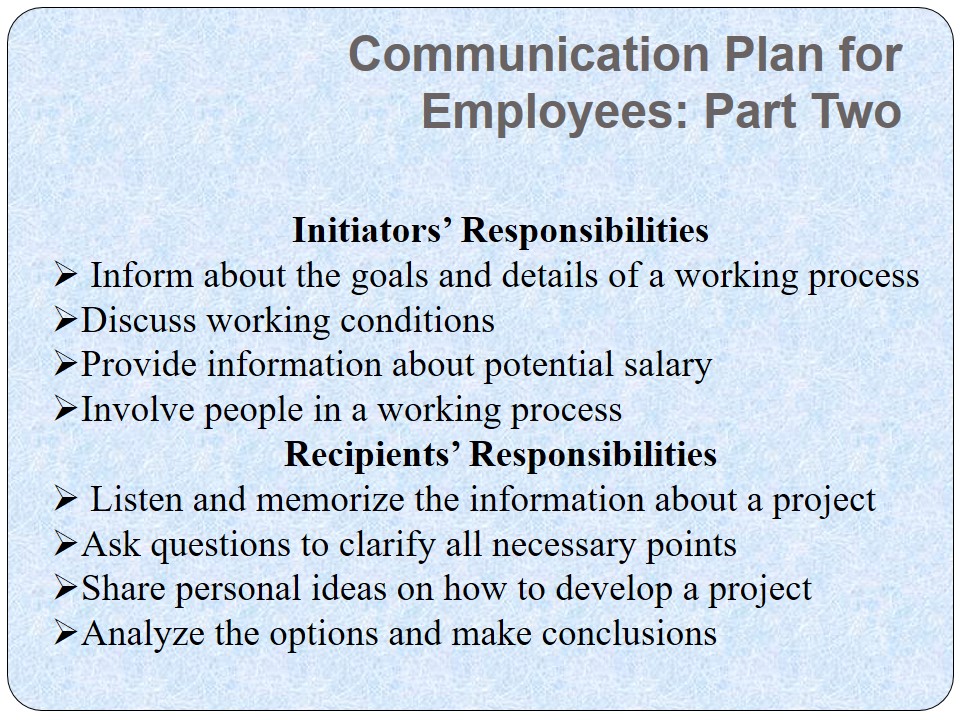
Communication Plan for Customers
- Mechanisms:
- Situational communication;
- Personal experience;
- Entertainment events.
- Frequency:
- 4-5 times during the project.
- Initiators’ Responsibilities:
- Attract customer’s attention;
- Explain what to expect from a project;
- Prove the worth of a project;
- Tell truth.
- Recipients’ Responsibilities:
- Listen;
- Pose questions;
- Make conclusions;
- Discuss.
Communication with customers is a crucial stage of project management. The way communication is organized can define the success or failure of a project. A manager should use situational communication as the main mechanism to be used on customers. It is possible to describe different situation and explain how the offered product can be used. A manager can share personal experience, desire to have the offered production, and the benefits of choosing the offered idea/product/service. Communication can be improved by means of entertainment events that can help to attract more customers.
As a rule, managers are free to identify as many meetings as possible. Still, the most important are the one at the beginning of the work, 3-4 during the project to inform about the details, and one at the end to explain the benefits of their solutions to use the offered product.
The responsibilities of both parties in this kind of communication are numerous (Heldman, 2011). Still, the most crucial are:
- Initiators’ Responsibilities:
- Attract customer’s attention (introduce a product);
- Explain what to expect from a project (identify benefits of the offered product);
- Prove the worth of a project (there are many options for customers to choose from, and this communication helps to underline the best aspects of this particular product);
- Tell truth (customers want to believe that all facts and ideas are credible; it is wrong to provide customers with empty promises).
- Recipients’ Responsibilities:
- Listen (to understand what product is offered);
- Pose questions (to clarify the doubts in regards to product);
- Make conclusions (to decide if it is necessary to use the offered production or not);
- Discuss (to share personal opinions and expectations and consider other thoughts).

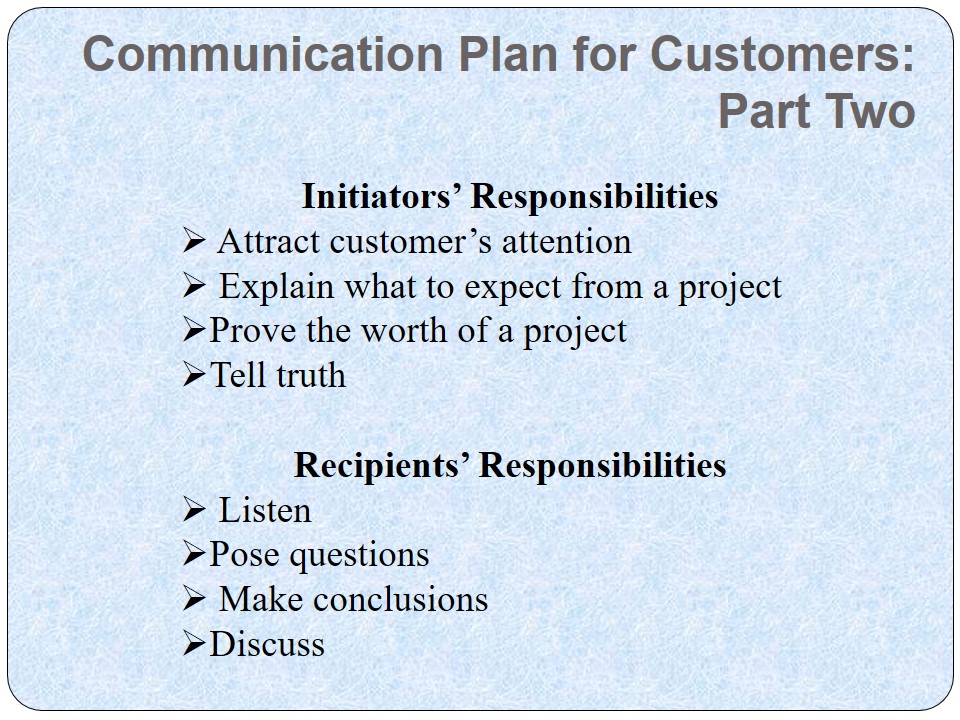
Communication Plan for Suppliers
- Mechanisms:
- Facts;
- Needs;
- Options.
- Frequency:
- Each time a delivery of sources is necessary.
- Initiators’ Responsibilities:
- Identify the professional needs;
- Explain expectations;
- Discuss the details of supplies.
- Recipients’ Responsibilities:
- Analyze the demands;
- Offer conditions;
- Provide evidence.
The communication between a manager and suppliers does not take a long time. It can be improved by means of clear facts, the identification of needs, and the explanation of options. A manager has to explain to the suppliers what is expected from them and why their cooperation is important for both parties. A manager should realize that suppliers can be chosen from a variety. That is why it is not necessary to beg, motivate, or invite suppliers. It is more important to explain the needs and choose from the options available.
Communication between suppliers and managers can be organized as many times as deliveries are defined.
Supplier-manager communication aims at discussing various working details. Though the manager is able to choose from a variety of options, it is not necessary to be too picky. It may happen that no suppliers want to cooperate with such a manager. The main responsibilities are as follows:
- Initiators’ Responsibilities:
- Identify the professional needs;
- Explain expectations;
- Discuss the details of supplies.
- Recipients’ Responsibilities:
- Analyze the demands;
- Offer conditions;
- Provide evidence.
Suppliers are important stakeholders for any project because they take responsibility for delivery of working resources. If some troubles or misunderstandings take place in such communication, the solutions should be offered in a short period of time.
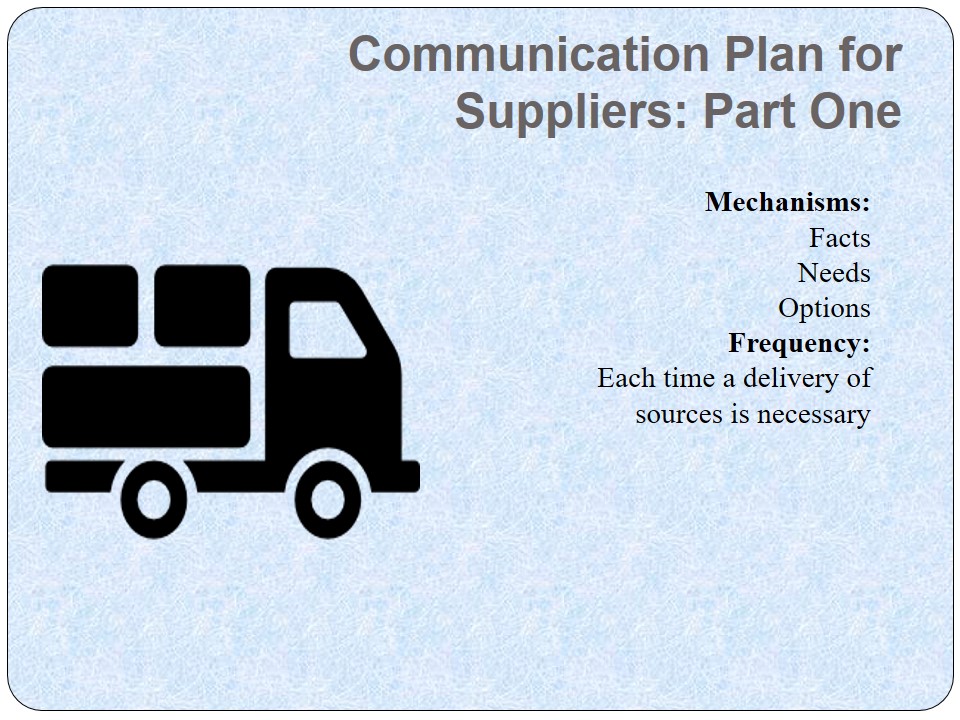
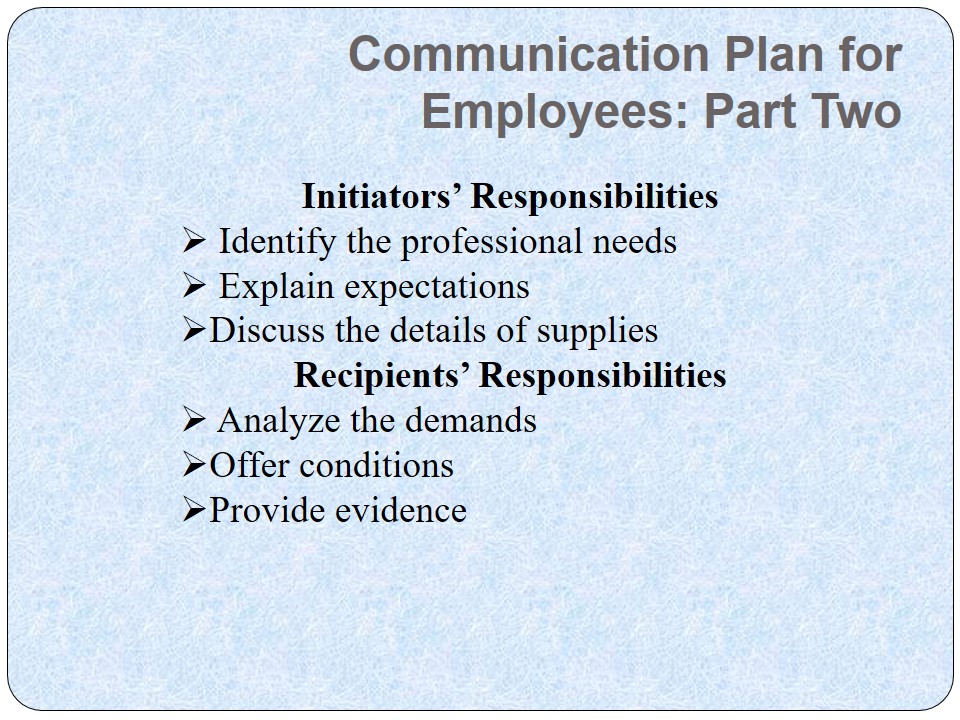
Rationale for Plan
- Identification of goals.
- Clarification of stakeholders.
- Choice of communication mechanism.
- Plan of meetings.
- Prediction of the results.
The rationale for a plan shows the effectiveness and the necessity of the work done in this kind of work. This communication plan and the identification of stakeholders provides an understanding of key issues of a project, the role of each person in work, and the expectations of a project.
These issues serve as the rationale for the plan offered:
- Identification of goals (managers and stakeholders learn why a project is offered).
- Clarification of stakeholders (managers comprehend which people are necessary for a project).
- Choice of communication mechanism (cooperation details are discussed).
- Plan of meetings (deadlines and expectations are pointed out).
- Prediction of the results (managers and stakeholders comprehend what they can achieve at the end of their work).
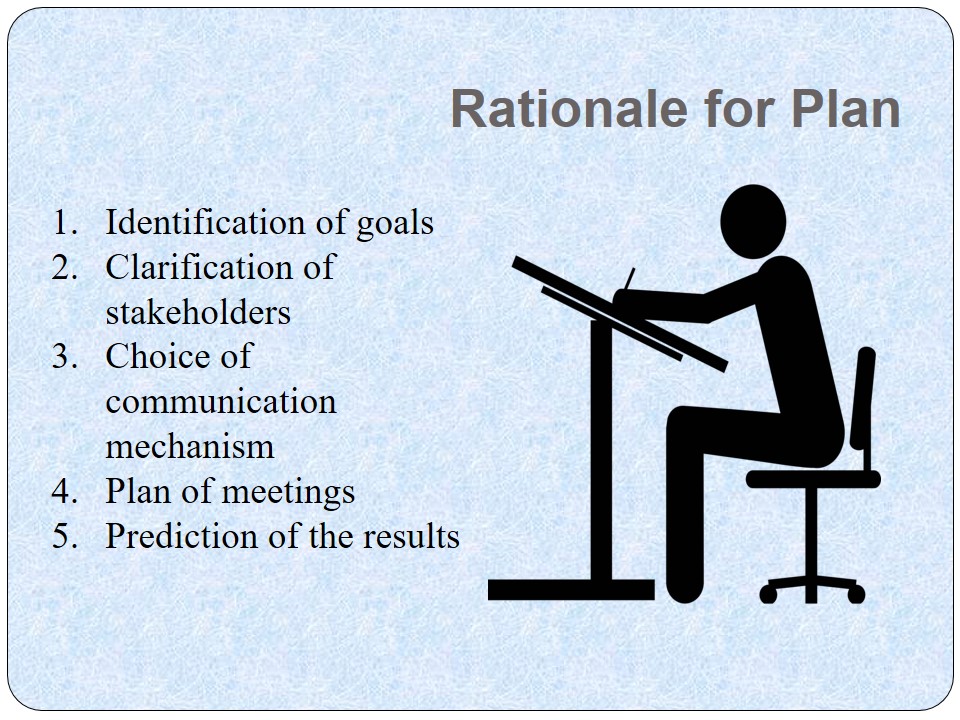
Reference List
Eskerod, P. & Jepsen, A.L. (2013). Project stakeholder management. Burlington, VT: Gower Publishing.
Flannes, S. & Levin, G. (2005). Essential people skills for project managers. Vienna, VA: Management Concepts.
Heldman, K. (2011). Project management jumpstart. Hoboken, NJ: John Wiley & Sons.
Kerzner, H. (2013). Project management: a systems approach to planning, scheduling, and controlling. New York City, NY: John Wiley & Sons, Inc.